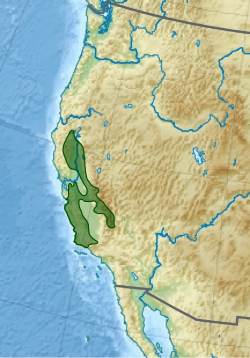Taxonomy
mtDNA sequence analysis [3] indicates a close relationship between the yellow-billed magpie and the black-billed magpie, rather than between the outwardly very similar black-billed and European magpies (P. pica).
Combining fossil evidence [4] and paleobiogeographical considerations with the molecular data indicates that the yellow-billed magpie's ancestors became isolated in California quite soon after the ancestral magpies colonized North America due to early ice ages and the ongoing uplift of the Sierra Nevada, but that during interglacials there occurred some gene flow between the yellow- and black-billed magpies until reproductive isolation was fully achieved in the Pleistocene.
The yellow-billed magpie is adapted to the hot summers of California's Central Valley and experiences less heat stress than the black-billed magpie. [5]
Behaviour
The yellow-billed magpie is gregarious and roosts communally. [6] There may be a cluster of communal roosts in one general area made up of a central roost containing many birds and several outlying roosts with fewer. [6]
Yellow-billed magpie flocks are known to engage in funeral-like behavior for their dead. When a magpie dies, a gathering of them congregates around the deceased bird where they call out loudly for 10–15 minutes. [7]
Breeding
The yellow-billed magpie prefers groves of tall trees along rivers and near open areas, though in some cities they have begun to nest in vacant lots and other weedy places. A pair of birds build a dome-shaped nest with sticks and mud on a high branch. [8] Nests maybe 14 meters above the ground and are sometimes built far out on long branches to prevent predators from reaching them. [5] They nest in small colonies, or occasionally alone. [8] Even when nesting close to other birds they may exhibit some territorial behavior. [5] These birds are permanent residents and do not usually wander far outside of their breeding range. [5]
Extra-pair copulation is not uncommon among yellow-billed magpies. After mating, a male will exhibit mate-guarding, preventing the female from mating with other males until she lays the first egg. [9] The clutch contains 5 to 7 eggs which are incubated by the female for 16 to 18 days. [5] Both parents feed the nestlings a diet of mostly insects until fledging occurs in 30 days. [5]
Diseases
This bird is extremely susceptible to West Nile virus. Between 2004 and 2006 it is estimated that 50% of all yellow-billed magpies died of the virus. [11] Because the bird tends to roost near water bodies such as rivers, it is often exposed to mosquitoes. [6]
Avian poxvirus is another contagious viral infection that Yellow-billed magpies face that have raised concerns for their population. It has been documented in some individuals, leading to the development of skin lesions, nodules, and sometimes death. While the prevalence of avian poxvirus in Yellow-billed magpies varies, it is considered a potential concern for the species.
The birds are also at risk of lead poisoning, primarily due to the ingestion of spent lead ammunition fragments found in carrion or discarded game animals. Lead poisoning has been a significant issue for scavenging birds, and efforts to reduce the use of lead ammunition in hunting areas adjacent to Yellow-billed magpie habitats are being undertaken to mitigate this threat.
Conservation
The IUCN classifies the bird as a vulnerable species. [1] The Nature Conservancy places it in the vulnerable category. [2] Besides West Nile Virus, threats include loss of habitat and rodent poison. [5] The bird has a limited area of distribution but is widespread throughout the area and still common in many places. [5]
Habitat Loss is the ongoing urbanization and agricultural development in California's Central Valley have led to the destruction and fragmentation of the Yellow-billed magpie's preferred nesting and foraging habitats. As groves of tall trees are cleared for development, the available breeding sites for these birds are diminishing.
Rodent Poison also is the use of rodenticides and pesticides in agricultural and urban areas poses a direct threat to the Yellow-billed magpie population. These chemicals can contaminate the bird's food sources and have detrimental effects on their health.
Climate Change and its associated impacts, such as increased temperatures and altered precipitation patterns, may affect the availability of the bird's food sources and nesting sites. Prolonged droughts and extreme weather events can further stress their populations.
Conservation Efforts where several organizations, including The Nature Conservancy and local conservation groups, are actively engaged in efforts to protect and preserve the Yellow-billed magpie. These efforts include habitat restoration, monitoring of populations, and education campaigns to raise awareness about the importance of safeguarding this species.
This page is based on this
Wikipedia article Text is available under the
CC BY-SA 4.0 license; additional terms may apply.
Images, videos and audio are available under their respective licenses.




